RESEARCH ON PHLOROTANNIN COLLECTION FROM BROWN ALGAE (SARGASSUM SERRATUM) IN NHA TRANG AND ASSAY APPLY TO ANTIOXIDANT BEVERAGE
Bạn đang xem bản rút gọn của tài liệu. Xem và tải ngay bản đầy đủ của tài liệu tại đây (979.25 KB, 40 trang )
MINISTRY OF EDUCATION AND TRAINING
NHA TRANG UNIVERSITY
------------------------Dang Xuan Cuong
RESEARCH ON PHLOROTANNIN COLLECTION
FROM BROWN ALGAE (SARGASSUM SERRATUM) IN
NHA TRANG AND ASSAY APPLY TO
ANTIOXIDANT BEVERAGE
SPECIALITY: Technology of fisheries processing
CODE:
62540105
ABSTRACT OF TECHNICAL DOCTOR THESIS
Khanh Hoa - 2015
Thesis was completed in:
Nha Trang university and Insititute of Technology Application and
Research.
Science instructor:
1. Dr. Vu Ngoc Boi
Nha Trang university
2. Ass. Pro. Dr. Tran Thi Thanh Van
Insititute of Technology Application and Research
Reviewer 1: Prof. Sci. Dr Nguyen Trong Can ........................
................................................................................................
Reviewer 2: Assoc. Dr Phung Thi Thanh Tu .........................
................................................................................................
Reviewer 3: Assoc. Dr Nguyen Anh Tuan .............................
................................................................................................
Thesis will be defened at the doctor thesis assessment committee of
Nha Trang university
……………………………………………………………………………
At …………hours ………..Date …… ………. ………..
The thesis can be found in:
The library of Nha Trang university or National library.
1
INTRODUCTION
1. Necessity of thesis
Brown algae (Phaeophyta) is bioactive-rich algae such as lamilaran,
fucoidan, alginate, phlorotannin, …. The substances have many bioactives,
inside, antioxidant, antibacterial, antifungal,… is being interested. Brown
algae phylum (Phaeophyta) has many families as: Alariaceae, Fucaceae
and Sargassaceae.
In Vietnam, brown algae genus (Sargassum) belong to brown algae
family (Sargassaceae). The genus has large output and high value on
medicine because they consists of many bioactive substances as fucoidan,
laminaran, alginate, phlorotannin,…. Inside, a noteworthy biocompound is
phlorotannin – a compound of secondary metabolism belong to phenolic
group. Phlorotannin has different bioactives such as: antioxidant,
antibacterial, antifungal, antitumor, anticancer,…. Antioxidant activity of
phlorotannin is one of the most extensively studied activities and
phlorotannin was known as non-toxic and safe antioxidants for human
healthy. Thus, phlorotannin can be exploited and used to support free
radical removal and health improvement for human body. Thence,
phlorotannin of brown algae was interested by researchers.
Nha Trang sea has abundant and diverse resource of brown algae
Sargassum in numerous and category. Alternatively, brown algae in Nha
Trang sea contains a high content of bioactive substances as fucoidan,
phlorotannin,
alginate,….
Therefore,
a
study
of
“Research
on
phlorotannin collection from brown algae (Sargassum serratum) in
Nhatrang and assay apply to antioxidant beverage” is necessary.
2. The target of the thesis:
- Research on antioxidant phlorotannin collection from brown algae
2
(Sargassum serratum) collected in Nhatrang sea, Khanhhoa.
- Assay apply phlorotannin into the antioxidant beverage.
3. The object and scope of research
3.1. The object of research
Brown algae (Sargassum serratum) growed in Nhatrang sea was
collected, cleaned by using salt water, dried until the humidity of 19%,
storaged in the room temperature and used for the research of phlorotannin
collection.
3.2. The scope of research: contain 5 parts
1) Extraction and optimization study on phlorotannin collection from
brown algae (Sargassum serratum) grown in Nhatrang sea, Khanhhoa.
2) Initial fraction and purification of phlorotannin collected from brown
algae (Sargassum serratum).
3) Study on a spray drying of brown algae S. Serratum extract to receive
phlorotannin powder.
4) Evaluation of a toxic of phlorotannin obtained from brown algae S.
serratum.
5) Assay apply phlorotannin to antioxidant beverage.
4. The method of research
The standard methods of the world and Vietnam used for the study of
phlorotannin obtainment from brown algae (Sargassum serratum) were
utilized in the thesis. The mathematic methods were also exploited to
discovery new rules, natures, and a relation between the quantity and
hyppothesis verification in the thesis.
3
5. The new contribution to the science
- This is the first time the comprehensive research on phlorotannin of
brown algae (Sargassum serratum) harvested at Nhatrang sea, Khanhhoa
was done. The research was from a optimization of the extraction step to
purification, assay of the toxic on mice, spray drying to create high
antioxidant phlorotannin powder and test a production of antioxidant
phlorotannin beverage. Thence, the research results of thesis have high
significance in science. These results contribute to affirm the value of
brown algae resource of Vietnam. Alternatively, the result of thesis will be
the reference to serve the study and teach-in the field of active element of
marine seaweed.
- The thesis results will be the basis for development and
commercialization of some products originated from brown algae
(Sargassum serratum) of Nhatrang sea at company of food production.
6. The structure of thesis
The thesis contains 171 pages, inside, a review of 34 pagas, a study
method of 22 pages, a result of 89 pages, a conclusion of 2 pages, a
references of 24 pages and a appendix.
4
CHAPTER I. OVERVIEW
1.1. INTRODUCTION OF BROWN ALGAE
Brown algae is a bioactive abundant and bioactive element – rich
resource, as antioxidant, antifungal, antibacterial, anticoagulant and antiradiation, healing effect and cell regeneration (Kang et al., 2003). In fact,
Khanhhoa province has 21 brown algae species, inside, Sargassum serratum
species is large distribution, great reserves and new species, they
simultaneously contains many bioactive compounds such as fucoidan,
phlorotannin,… but they have never been fully studied.
1.2. INTRODUCTION OF PHLOROTANNIN
Phlorotannin is one of strong antioxidant compounds originated from
brown algae (Ahn et al. (2007); Kang et al. (2003); LIM (2002); Kuda
(2007) and Shibata (2008)). Phlorotannin contains basis units of
phloroglucinol (1,3,5-trihydroxybenzene), and their molecular size oscillate
between 126 Da and 650 kDa (Singh et al. (2006)), and characteristic
linkages of phlorotannin structure are the linkage of ether, phenyl, ether and
phenyl, dibenzodioxin (La Barre et al. (2010)). It is very interesting, a
content, structure and antioxidant mechanism of polyphenol/ phlorotannin
in brown algae closely related to antioxidant activity. Phlorotannins is a
phenolic compound and their nature is polymer of phloroglucinol. They
exist in many families of brown algae phylum, such as: Alariaceae,
Fucaceae and Sargassaceae. Thus, phlorotannin is worth bioactive agent to
study.
1.3. SITUATION OF PHLOROTANNIN STUDY IN THE WORLD
AND VIETNAM
* Situation of phlorotannin study in the world
Many studies showed that, phenolic compound in brown algae is
5
phlorotannin (Jormalainen et al. (2004); Koivikko et al. (2007); Swanson et
al. (2002)). Siti A. Budhiyanti et al. (2012) published free radical
scavenging (DPPH) oscillated from 14.61 to 48.71% and 0.17 to 44.05%,
respectively, when extract of cell membrane and cytoplasm has a
concentration of 0.45 mg/ml; reducing power activity vacillated conforming
2.05 to 12.51% and 26.77 to 68.80%, when extract of cell membrane and
cytoplasm of some Sargassum species harvested in Indonesia sea has the
concentration of 0.45 mg/ml, all extract consist of phlorotannin. EC50
oxidant index performed DPPH free radical scavenging activity of species
S. ramifolium and S. pteropleuron was from 6.64 to 7.14 mg/ml (Mayalen
Zubia et al., 2007). Free radical scavenging activity of species S. thunbergii
and S. fulvellum was 97.41% and 84.66%, respectively, was simultaneously
showed by Soo Jin Heo et al. (2005). Strong antioxidant activity of purify
phlorotannin originated from some brown algae species has closely relation
to skeleton molecular (Ahn et al. 2007). A activity and vitality of
phlorotannin is diverse in different species of Sargassum in the worldwide,
therefore. All over the study and a announcement of Barry Halliwell (2001)
performed, phlorotannin has a minimizing power of cell damage under a
impact of free radicals such as: superoxide, hydroxyl, peroxyl, alkoxyl,
hydroperoxyl, nitric oxide and nitrogen dioxide. The thing was also
evidenced by Naja et al., 2012, (.OH) and (O2-) radical scavenging ability of
S. ringgoldianum species got 78% and 88.4%, respectively, and free radical
scavenging activity (DPPH) of S. vulgare species was 0.2% ÷ 20.3%. Total
antioxidant activity of S. pallidum species also oscillated from 0.04 ± 0.02
to 52.08 ± 0.02µmol FeSO4/mg (Hong Ye et al., 2009).
* Situation of phlorotannin study in Vietnam
Early studies of antioxidant phlorotannin extracted from Vienamese
brown algae were announced in the years 2009. However, first publications
6
about antioxidant activity of algae species grown in Nhatrang sea Khanhhoa, Vietnam were announced in the years 2010 and the publications
were noticed by the group of author.
1.4.
APPLY
OF
SPRAY
DRYING
TO
PREPARE
PHLOROTANNIN POWDER
In fact a technique of spray drying will help to transform active agents
from a liquid state into a powder state, remove almost solvent, cost-saving
of shipping, lengthen a shelf-life of active element and a formation of
microcapsule (the most important thing), stable improvement of active
element through linkage and packaging capacity of drying aid added in a
process of spray drying. Accordingly, the technique of spray drying is very
suitable to prepare antioxidant phlorotannin powder originated from marine
algae.
Over analysis shows that it have not any publication of extraction,
optimization,
spray
drying
of
powder
preparation,
application,
determination of phlorotannin structure or screening and evaluation of
phlorotannin content and reserve according to a crop and growing time of
each parts of algae or storage time of brown algae Sargassum serratum
grown in Nhatrang sea, Khanhhoa, Vietnam. Therefore, the thesis focus on
over researchs.
7
CHAPTER II. MATERIAL AND METHOD OF RESEARCH
2.1. Material
Brown algae (Sargassum serratum) belong to: phylum (Phaeophyta),
class (Phaeophyceae),
order
(Fucales),
family (Sargassaceae),
genus (Sargassum).
Brown algae (Sargassum serratum) grown in Nhatrang sea - Khanhhoa
was collected, cleaned by using a salt water, dried until the humidity of
19% and storaged in a room temperature to use in the research.
2.2. The method of research
2.2.1. The analysis method
2.2.1.1. The quantification of phlorotannin: determined according to
Swanson et al. 2002. Phloroglucinol was used as a standard.
2.2.1.2. Determination of antioxidant activity
+ Determination of total antioxidant activity (TA): quantified in
accordance with Prieto et al. (1999). Acid ascorbic was used as the
standard.
+ Reducing power activity (RP): evaluated by the method of Zhu et al.
(2002). The standard of FeSO4.
+ (DPPH) free radical scavenging activity: measured on Blois M. S. (1958).
Absorbant value was measured by using UV-Vis Spectrophotometer
JenWay 6400/6405 machine.
2.2.1.3. Determine of colour degree of beverage: determined by the
method of UF treatment of Neslihan et al. (2005).
2.2.1.4. Quantification of other compositions
- Carbohydrate content: quantified by the method of AOAC (1990).
8
- Pb content: measured on the Vietnamese standard of 7602:2007-Food
- Citric acid content: determined according to AOAC (1932).
- Sucrose sugar: explained by AOAC (2000).
2.2.2. The method of purification
Each fraction is analysed by thin layer chromatography and the solvent
system of elution is chloroform: methanol: acid formic (90: 9: 1).
Phlorotannin have been detected with 5% FeCl3 reagent (5% FeCl3 in 96%
ethanol). The purification of sample on thin layer chromatography was
tested by LC/MS and phlorotannin analysis according to the method of
Swanson et al. The most purificatory fraction of phlorotannin was loaded
onto the Sephadex LH 20 column and the solvent system of chloroform :
methanol : acid formic was used to elute, the ratio of 90 : 9: 1, respectively.
The fraction of purificatory phlorotannin got from LH 20 column was
analysed by 1H and
13
C NMR spectroscopy. (mobile phase contains: A
phase of H2O and 0.1% formic acid, B phase of acetonitril and 0.1% formic
acid). The analysis method of HPLC-MS, recognition of element by using a
m/z score.
- A gradient programme run LC/MS as follow:
Table 2.1. Gradient programme on LC/MS
Time
Phase B (%)
0
10
10
10
40
90
60
90
61
10
70
10
9
2.2.3. The method of sensory evaluation: theo phương pháp cho điểm
theo tiêu chuẩn Việt Nam 3215-79 với thang điểm 20 để đánh giá chất
lượng cảm quan của sản phẩm.
2.2.4. The method of bacterial quantification
- Determine of total aerobic bacteria (KL/ ml) according to the Vietnam
standars of 4884:2005.
- Deterimine of E. coli according to the Vietnamese standars of
6848:2007.
- Determine of Coliforms according to the Vietnamese standars of
6846:2007.
- Determine of C. perfringens according to the Vietnamese standars of
4991:2005
- Determine of Streptococci faecal according to the Vietnamese standars
of 6189-2:1996.
- Determine of Pseudomonas aeruginosa according to the standars of
ISO 16266:2006.
- Determine of Staphycus aureus according to the Vietnamese standars
of 4830-1:2005.
- Determine of total spores of yeast and mold (BT/ml) according to the
Vietnamese standars of 5166:1990.
2.3. Diagram of general experiment
Layout of general experiment of studying process was shown in fig 2.1.
10
Brown algae Sargassum
Cleanness
Drying
Mincing
Extraction
Filter
Concentration
Spray drying
phun
Fraction
Assimilation
Dialysis
Pouring
Concentration
Air removing
Purification
Evaluation:
+ Phlorotannin content
+ Antioxidant activity:
- Total antioxidant activity
- Reducing power
- DPPH
+ Degree of colour (for beverage)
+ Microorganism (for storage of
beverage)
Phlorotannin
powder
LC/MS
Lid closing
Pasterization
Cooling
Labeling sticking
Storage
Fig 2.1. Diagram of general experiment layout
11
Based on diagram of general experiment layout, suitable factors of each
studying step were established.
2.3. CHEMICAL AND ACCESSORIES
2.3.1. Chemical
- Chemicals were used for the study: HCl, Na2CO3, H2SO4, sodium
phosphate, ammonium molybdate, đệm phosphate, K3[Fe(CN)6],
CCl3COOH, FeCl3, the standard of FeSO4 and ascorbic acid,
phloroglucinol,…, DPPH, ethanol, n-hexan, ethyl acetate, chloroform, All
chemicals were pure and provided by Merck – Germany and Sigma American. 96% ethanol of Vietnamese.
- Addition of food: citric acid, ascorbic acid, carrageenan, sacharose,...
were pure additions and used for the medicine and food. All additions were
provided by Merck – Germany.
2.3.2. Accessories
Accessories of an analysis chemical and technology development
laboratary of Nhatrang Institute of Technology Development and Research
and a lab of biotechnology – a centre of practise analysis – Nhatrang
university were used to obtain: thermostat equipment - Memment
(Germany), machine of pH HANA (American), equipment of vacuum
concentration (Germany), the machine of spray drying Bucchi - Thụy Sỹ,
máy so mầu UV- VIS - American,….
2.4. DATA ANALYSIS
Data analysis and estimation of surface by using a software of Design
Expert 8 trial, Nemrodw and Excell. Each experiments was repeatted 3
times. Unusual value was removed by using Dulcan method.
12
CHAPTER III. RESEARCH RESULTS AND DISCUSSION
3.1. PHLOROTANNIN EXTRACTION FROM BROWN ALGAE
S. SERRATUM
3.1.1. Determine of extraction solvent of phlorotannin
The results showed the effect of extracting solvent on phlorotannin
content (Phc) and antioxidant of extract is very strong. In 2 extracting
methods (reflux and maceration), Phc and antioxidant activity of different
extract decrease in the following order: ethanol > acetone > ethyl acetate >
chloroform > n-hexan. The results showed the effect of maceration method
is better than that of reflux method. This thing exhibite Phc and antioxidant
activity is extracted more when the maceration method was used. In the
method of reflux, phlorotannin content, the activity of total antioxidant
(TA) and reducing power (RP) of extract only got 98.19%, 91.12% and
93.89%, respectively, compared to the method of maceration.
Thus, ethanol was choiced as the extracting solvent and the maceration
method was used to extract phlorotannin from brown algae.
3.1.2. Determine of the concentration of ethanol
The results noticed 96% ethanol was collected to extract phlorotannin
from brown algae S. serratum, Phc, TA, and RP of collected extract is the
highest. ANOVA and regression analysis showed the significant difference
between the target functions (Phc, TA, and RP) in various conditions is
exhibited and their close correlation is also detected (R2 > 0.8). In addition,
a changes of these target functions is exhibited according to the non-linear
function of level 2. Thus, 96% ethanol was used to extract phlorotannin
from brown algae S. serratum.
3.1.3. Determine of the ratio of solvent-to-material
Phc, TA and RP of extract got the highest value and 4.102 ± 0.005mg
phloroglucinol equivalent /g dry weight (DW), 4.279 ± 0.001 mg ascorbic
13
acid equivalent /g DW and 24.228 ± 0.014 mg FeSO4 equivalent /g DW,
respectively, when phlorotannin was extract by 96% ethanol and the
DM:NL ratio of 40:1 (v/w) from brown algae S. serratum. If the ratio of
solvent-to-material of 10:1 (v/w) was used to extract, Phc, TA, and RP of
extract only got 57.80%, 73.63%, and 86.50%, respectively, compared to
the solvent-to-material ratio of 40:1 (v/w). If the solvent-to-material score
of 30:1 (v/w), Phc, TA, and RP of extract only got 86.57%, 96.79%, and
86.89%, respectively, in comparation to the ratio of solvent-tot-material of
40:1 (v/w). When the solvent-to-material score of 50/1 (v/w) was used, Phc,
TA, and RP was 96,32%, 96,61%, 96,65%, respectively, compared to the
ratio of solvent-to-material of 40:1 (v/w). Consequently, the ratio of
solvent-to-material of 40:1 (v/w) was choiced to study the phlorotannin
extraction from brown algae S. serratum.
3.1.4. Determine of the temperature of extraction
The analysing results of ANOVA and regression showed phlorotannin
content and antioxidant activity of the extract get the highest value when
phlorotannin was extracted from brown algae (S. serratum) at the
temperature of 500C. Therefore, the temperature of 500C was choiced to
extract antioxidant phlorotannin from brown algae.
3.1.5. Determine of the time of extraction
The analysing results noticed a change of Phc on the extracting time
exhibited in non-linear function of level 2, the results is also similar in the
publication of Dang Xuan Cuong, Tran Thi Thanh Van, Vu Ngoc Boi, Bui
Minh Ly (2014) about the phlorotannin extraction from brown algae S.
mcclurei [10]. RP of extract on various extracting time is a statistical
signification and a good correlation between the extracting time and TA is
happened. Moreover, a close relation between Phc, TA and RP is found, a
relation of Phc and TA is stronger than other relations. The relation is
14
exhibited through the changes of phlorotannin on the extracting time. When
the extracting time is enough, diffusion of phlorotannin from brown algae
outgoing is the highest. When the extracting time is too long, phlorotannin
be destroyed and phlorotannin content was decreased. The results showed
Phc, TA and RP of extract get the highest value in the extracting time of 32
hours. Hence, the extracting time of 32 hours was choiced to extract
phlorotannin and antioxidant from brown algae S. serratum.
3.1.6. Determine of pH of extracting solution
The analysing results of ANOVA and regression showed a positive
correlation between pH of extracting solution and antioxidant activity of
extract is exhibited (R > 0.9). In addition, a strong correlation between Phc
and TA was detected (R2 = 0.95) and the correlation is changed according
to the non-linear function of level 2 in the strong effect of solvent pH. A
normal correlation between Phc and RP is also found (R2 = 0.65). The
results is similar in the publication of Dang Xuan Cuong, Tran Thi Thanh
Van, Vu Ngoc Boi, Bui Minh Ly (2014) about the phlorotannin extraction
from brown algae S. mcclurei.
The results of over analysis showed that solvent of pH 7 is suitable to
the extracting process of phlorotannin from brown algae S. serratum. Thus,
solvent of pH 7 was selected to extract phlorotannin from brown algae S.
serratum.
From over studies announced some suitable factors of antioxidant
phlorotannin extraction from brown algaae Sargassum serratum were
choiced as the basis condition of processing optimization of phlorotannin.
The condition is as follow: the temperature of 500C, the time of 32 hours,
96% ethanol solvent, the ratio of solvent-to-material of 40:1 (v/w).
15
3.2.
OPTIMIZATION
OF
EXTRACTING
PROCESS
OF
PHLOROTANNIN USING BOX-BEHNKEN MODEL
After some conditions of phlorotannin and antioxidant activity
extraction from brown algae S. serratum were determined. The experiments
of step optimization of phlorotannin from brown algae S. serratum were
designed and inlet factors such as: the temperature (U1: 24 - 600C), the time
(U2: 16 - 42 giờ) and the ratio of solvent-to-material (v/w) (U3: 10 - 50).
Target functions were phlorotannin content (mg phloroglucinol euquivalent
/g), Y2: total antioxidant activity (mg ascorbic acid equivalent /g), Y3:
reducing power activity (mg FeSO4 equivalent /g). The opitimal result was
performed in table 3.1 and 3.2, fig 3.1.
Table 3.1. The optimal results of extracting step of phlorotannin from
brown algae S. serratum using Box-behnken model
U1
U2
U3
X1
X2
X3
Y1
Y2
Y3
24
16
30
-1
-1
0
1.607
1.652
1.575
60
16
30
1
-1
0
1.292
3.640
6.650
24
42
30
-1
1
0
1.071
1.666
7.630
60
42
30
1
1
0
1.607
5.180
10.080
24
29
10
-1
0
-1
1.512
2.100
11.200
60
29
10
1
0
-1
1.670
4.970
10.325
24
29
50
-1
0
1
0.914
1.246
6.020
60
29
50
1
0
1
2.394
6.300
11.830
42
16
10
0
-1
-1
2.079
2.772
8.190
42
42
10
0
1
-1
5.796
15.316
44.835
42
16
50
0
-1
1
2.142
1.736
3.780
16
42
42
50
0
1
1
3.087
5.754
18.410
42
29
30
0
0
0
6.017
15.400
45.150
42
29
30
0
0
0
6.080
15.442
45.080
42
29
30
0
0
0
6.048
15.414
45.010
(A) Response surface
of target function Y1
(B) Response surface
of target function Y2
(C) Response surface
of target function Y3
Fig 3.1. Model 3D of response surface
Table 3.2. The results of repeated experiment in the optimal point
X1
(0C)
X2
(h)
X3
(v/w)
Y1
Y2
Y3
DPPHtb
43
33
27:1
5.92
15.06
45.27
61.55
43
33
27:1
5.98
15.11
45.34
64.66
43
33
27:1
5.96
14.99
45.29
65.75
X1
X2
X3
(0C)
(h)
(v/w)
0.2 ml
0.4 ml
0.6 ml
0.8 ml
1 ml
43
33
27:1
34.00
58.60
71.50
80.32
82.11
43
33
27:1
33.70
57.40
69.90
79.70
82.59
43
33
27:1
36.00
59.80
70.23
81.40
81.30
DPPH (%)
17
Note: DPPHtb: DPPH free radical scaevenging activity
The optimal result is suitable for the data of experiment tested in the
extracting step of antioxidant phlorotannin from brown algae Sargassum
serratum. From the result, the optimal condition of phlorotannin collection
from brown algae S. serratum was as follow: the solvent of 96% ethanol,
the temperature of 430C, the ratio of solvent-to-material (DM:NL) of 27:1
(v/w) and the time of 33 hours.
* Determine of extracting times
The results showed total Phc of 3 extracting times increase trivial, compared
to Phc of 1st extracting times when 96% ethanol was used to extract phlorotannin
from brown algae S. serratum. In addition, if 3 extracting times was realized,
total volumn of used ethanol is very much. Moreover, the economical effect do
not has, because Phc was collected very few in 2 nd extracting times and 3rd
extracting times. Thus, phlorotannin was only extracted 1 times to ensure a
economical and efficient extraction.
3.3. STUDY OF CONCENTRATION OF PHLOROTANNIN
EXTRACT
PHLOROTANNIN
FROM
BROWN
ALGAE
S.
SERRATUM
After the filtered extract collected from brown algae S. serratum was
inspissated at various temperatures of 400C, 500C, and 600C, respectively,
the results noticed the condensing temperature increase, Phc and
antioxidant activity of jelly were decreased and changed according to a
linear function and the condensing temperature of 400C impacted less into
phlorotannin content and antioxidant activity. Thus, the temperature of
18
400C, the presure of 3mbar and the condition of cooled reflux was choiced
to concentrate antioxidant phlorotannin extract from brown algae.
3.4. STUDY OF PHLOROTANNIN PURIFICATION USING THE
TECHNIQUE OF FRACTION AND GEL SEPHADEX LH 20 GEL
CHROMATOGRAPHY
3.4.1. Purification by using gel chromatography of Sephadex LH 20
Phlorotannin-rich concentrated extract was fracted by using various
solvent and exhibited the following order: n-hexan, chloroform, ethyl
acetate, n-butanol. Most pure fraction was loaded onto the column of
sephadex LH 20, 2x25cm column, 10ml were collected from each fractions.
The results were shown in fig 3.2 and 3.3.
Phlorotannin (g PE/g DW)
2.0
40
TA (g AAE/ g DW)
35
RP (g FeSO4 equivalent / g DW)
30
25
1.5
20
1.0
15
10
0.5
5
0.0
0
n-hexan
Chloroform
Ethyl acetate
n-butanol
Water
Fraction
Fig 3.2. Phlorotannin content and antioxidant activity of diferent
fractions
Reducing power activity
Phlorotannin content and total
antioxidant activity
2.5
19
300
Plc (mg PE/10ml)
TA (mg AAE/10ml)
RP (mg FeSO4 equivalent/10ml)
60
50
250
200
40
150
30
100
20
50
10
0
Antioxidant activity
Phlorotannin content
70
0
0
10
20
30
40
Fractions after the column Sephadex LH 20
Fig 3.3. The chromatogram of phlorotannin –rich ethyl acetate fraction loaded onto the
gel chromatography of Sephadex LH 20, column 2x25cm, 10ml/ fraction
Table 3.3. Abstract of process of phlorotannin purification
Phase of
purification
STT
I
Initial extract
st
Phlorotannin
content (g
phloroglucinol
equivalent /g
DW)
Antioxidant activity
DPPH free
radical
scavenging (%)
Total antioxidant
activity (g
ascorbic acid / g
DW)
Reducing
power activity
(g FeSO4/ g
DW)
0.3173 ± 0.0050
63.98 ± 0.1
0.7589 ± 0.0042
1.8616 ± 0.0034
II
1 concentration
0.3096 ± 0.0040
60.14 ± 0.05
0.7598 ± 0.0037
1.8540± 0.0018
III
2nd concentration
0.3058 ± 0.0020
58.20 ± 0.09
0.7434 ± 0.0026
1.7524± 0.0021
IV
Fraction by using various organic solvent
1
N-hexan
0.2980 ± 0.0032
68.52 ± 0.08
0.3063 ± 0.0017
1.2499 ± 0.0026
2
Chloroform
0.2060 ± 0.0011
70.84 ± 0.16
0.4785 ± 0.0036
2.0169 ± 0.0030
3
Ethyl acetate
0.8179 ± 0.0025
86.53 ± 0.21
2.1444 ± 0.0010
10.5862±0.0016
4
n-butanol
0.5194 ± 0.0030
80.61 ± 0.17
0.5743 ± 0.0026
2.8197 ± 0.0018
0.1748 ± 0.0050
76.55 ± 0.23
0.1812 ± 0.0040
0.8866 ± 0.0023
Residual water
5
solution
V
Fractions after the gel chromatography of sephadex LH 20
1
Peak 1
93.2240 ± 0.0012
91.72 ± 0.25
0.9720±0.0014
4.6274 ± 0.0013
2
Peak 2
93.2964 ± 0.0015
92.08 ± 0.20
0.9462 ± 0.0017
4.2743 ± 0.0011
20
The results noticed that the content and purity of phlorotannin from
brown algae Sargassum serratum is the highest found in ethyl acetate
fraction. The thing created an advantage for evaluation and determination of
polyphenol component and character of their structure.
3.4.2. Evaluation of phlorotannin purity
The purity of fractions collected from the process of solvent fraction and
fractions received after the gel column of sephadex LH 20 was evaluated on
the thin layer chromatography and LC /MS, respectively. The results of
purity evaluation were performed in fig 3.4 ÷ 3.12.
Fig 3.4. Ethanol extract
on TLC before spray
reagent
Fig 3.5. Ethanol extract on
TLC after spray reagent
Fig 3.6. Ethyl acetate
fraction on TLC after
spray reagent
21
Fig 3.7. LC/MS chromatogram of
Fig 3.8. LC/MS chromatogram of
the initial ethanol extract
n-hexan fraction
Fig 3.9. LC/MS chromatogram
Fig 3.10. LC/MS chromatogram of
of chloroform fraction
ethyl acetate fraction
22
Fig 3.11. LC/MS chromatogram
Fig 3.12. LC/MS chromatogram of
of n-butanol fraction
the residual water fraction
ANOVA analysis noticed that data of fractions 12-16 and 22-34 is
significant difference (p < 0.05). Phlorotannin content of fractions 22-34 is
higher than that of fractions 12-16, so they were analysed by using NMR.
The results of analysis performed that collected phlorotannin focus on a low
frequency and their purity of over 92%. Phlorotannin content and
antioxidant activity of ethyl acetate fraction is the highest in comparision to
studied fractions. Active element of antioxidant phlorotannin loaded onto
the column of sephadex LH 20 has the purity of over 92%. However,
deeper studies need to realize to determine what agent of phlorotannin
(polyphenol) group.
3.4.3. Promotion of process of phlorotannin extraction from brown
algae S. serratum
Process of phlorotannin extraction from brown algae S. serratum was
expressed in the fig 3.13.
23
Brown algae
Extraction
The time: 33 hours
The temperature: 430C
The solvent-to-materila ratio: 27:1 (v/w)
Filter
Concentration
1st fraction
fraction nhexan
2nd fraction
Fraction
chloroform
3rd fraction
Fraction
EtOAC
4th fraction
Fraction
butanol
Final solution
Eluent solvent system:
Chloroform : methanol : acid
formic: 90:9:1
Chromatogr_
aphy
Sephadex LH
20
Pure
phlorotannin
Fig 3.13. Diagram of pure process of
phlorotannin from brown algae S. serratum
* Description of process
+ Material
Brown algae Sargassum serratum was harvested in Nhatrang bay Khanhhoa, Vietnam. After, brown algae was cleaned, classified and dried
until the humidity of 19%. Phlorotannin content usually get about 0.6% in
comparision to dried brown algae.
+ Extraction
Phlorotannin was extracted from minced and dried brown algae by using
96% ethanol at the temperature of 430C in the time of 33 hours and the
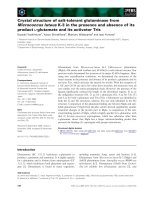
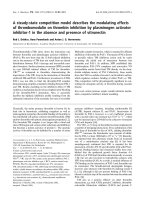
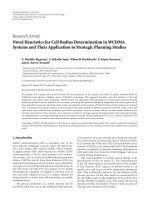


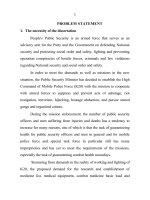
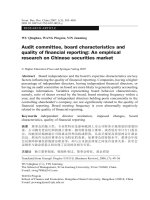
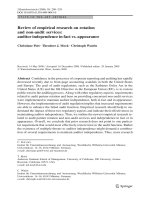
![bauer et al - 2007 - the impact of cg on cp - evidence from japan [gmi]](https://media.store123doc.com/images/document/2015_01/06/medium_tkx1420548520.jpg)
